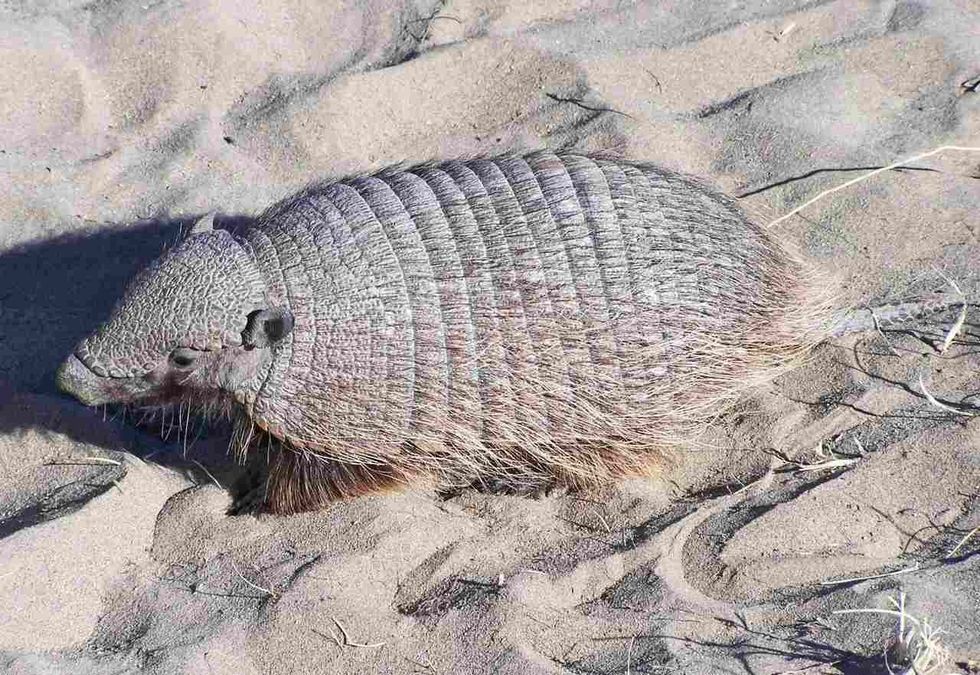Armadillos are called 'little armored ones'.
Most armadillo species are crepuscular, nocturnal, or both. That means they have natural vision during both dawn and dusk.
Examples of armadillos are the pink fairy armadillo and the southern three-banded armadillo. These mammals come under the order Cingulata. Anteaters and sloths are close relatives of armadillos.There are 21 living species of armadillos.
They are found mostly in Central America. They prefer eating invertebrates and plant matter. The other interesting fact about armadillos is that twin births are common, and their babies are called pups.
An armadillo is neither a rodent nor a marsupial but it is a placental mammal-like animal. An armdillo has covered its backs, head, legs, and tail with hard bony plates. They have stout legs.
These are the only persisting mammals with such shells. Do these bony shells serve any purpose? They do in defending armadillos from predators, and also from thorny bushes and shrubs.
Coming to the features of armadillos, they have point-shaped or shovel-shaped snouts and small orifices. They are generally considered odd creatures due to their body features.
Armadillos widely differ in size and color, and there are about 20 living species of armadillos. The largest armadillo found in nature is dark brown in color. It is called a giant Armadillo and is about 2.5-6.5 kg (5.5-14.3 lb) and its height is about 15-25 cm (5.9-9.8 in).
The most common armadillos are the nine-banded armadillo and the pink-colored fairy armadillo. Other armadillos have black, red, gray, or yellowish coloring.
Armadillos are likely to live in warmer regions due to their low metabolic rate. These creatures are originally native to South America but now they are vastly present in northern regions like Texas, Oklahoma, Kansas, and Louisiana.
They also select their habitat according to the soil conditions, picking soil that they can easily dig whenever the surrounding environment is cool.
Isn’t it so interesting that armadillos can walk underwater? If you find these facts intriguing, check out our other articles like what do chinchillas eat and what do kangaroos eat.
How To Feed Armadillos
Feeding armadillos is a real ordeal! If you have a pet armadillo, you need to give it a diet that is quite similar to the diet of wild armadillos.
But, don't worry if you do have a pet armadillo, because we will give you all the information you need regarding feeding your armadillo.
Most healthy armadillos that are adults won't require your help for feeding purposes. If you see an armadillo in the wild, you don't need to worry about its food sources because armadillos can fend for themselves very well.
Suppose you have rescued a stranded armadillo and now you want to know how to take care of it.
Remember that its claws will not harm you because armadillos are very docile in nature. Keep in mind that even if an armadillo is staying at your house, it needs to forage and dig as those are its natural tendencies.
You can arrange for a pen in the backyard of your house, or you can make a fenced-in yard for your pet armadillo and it will be able to dig the earth there.
For feeding an armadillo, you can look for moist canned food on the internet. This type of food comes with all the nutrients and supplements your pet armadillo might need to stay healthy. But, an armadillo in captivity cannot just eat canned food, it also needs natural foods as well.
You can try to give it worms, fruits, and grubs. Also, all armadillos love water. If you can find a wading pool for them, they will really enjoy spending time swimming.
Armadillos are very different creatures. Though they have tremendous claws on their feet, they do not show any hunting instincts. When they are not in captivity, they might go hunting once in a while at night. Mostly, they just survive on fruits and grubs.
At other times, they sleep for over 16 hours at night, so they do not need too much energy. These armadillos can also be distinguished by the type of armor present on their backs. This armor makes them unique.
According to the IUCN, many species of armadillos are Endangered and at the same time Vulnerable. Vulnerable species like the Andean hairy armadillos' population has declined by more than 30% in the last 21 years and the giant armadillos' population has declined by 30% in the last 10 years.
In the next few years, there is a high possibility that some of the species will become Extinct, according to the IUCN.
What do baby armadillos eat?
Baby armadillos are very sensitive creatures and if you find one, it is better leave it alone because baby armadillos can only thrive when they are with their moms. However, what if you have found an armadillo kid who has lost his mother to a road accident?
You should rescue the baby and call animal rescue. Baby armadillos love playing with a ball!
Are you wondering what you should feed it? No, problem! We've got you.
For armadillos that are still in the nursing stage, you need to use a regular kitten formula and feed the armadillo baby with a dropper. Do not force-feed the baby armadillo because this will only make it nervous and it won't trust you.
The less afraid an armadillo pup is, the better and easier it will be to take care of it. If armadillo pups eat too much food, they can get a dangerous case of gastric distress that may even be fatal.
What do armadillos eat in the wild?
Armadillos are omnivores and they are not predators by nature. An interesting fact is that most species of armadillos have the same diet. They eat insects, invertebrates. There are three armadillo species that are an exception and they are the southern three-banded armadillo, the pink fairy armadillo, and the nine-banded armadillo.
They feed on ants and termites. Banded armadillos are very rare. Most armadillos eat insects, small animals, and their eggs, plants, and water.
Insects: Armadillos catch insects like ants, beetles, and termites with their long, sticky tongues. Insects and their larvae constitute more than 90% of an armadillo’s diet.
Species such as the southern long-nosed armadillo eats crickets, ants and, termites. There are even other species, such as the nine-banded armadillo, that consumes ants, arachnids, termites, earthworms, millipedes, centipedes, and grasshoppers. Some other species such as southern three-banded and pink fairy armadillos have a diet that consists of ants termites.
Small animals: Some species of armadillos consume salamanders, toads, frogs, lizards including skills, and even small snakes. Common species like the giant Armadillo and nine-banded armadillos eat small reptiles, bird eggs, and small vertebrates. Sometimes, armadillos also behave as scavengers when they are deprived of their food.
Plants: Plants only constitute about 8% of their diet. They largely consume vegetable matter and delicate leaf origins. Armadillos eat vegetables that they can find in their area. In the grasslands, they can eat lettuce, leafy greens, and pumpkins. Some armadillos prefer fruits like berries and wild fruits like star fruit and wood apple in the summer
Species like southern long-nosed armadillos, giant armadillos, pink-colored fairy armadillos consume fewer plants when compared to other armadillos.
Water: Armadillos keep hydrated by drinking water and they even enjoy drinking water. They expand their intestines and float on the riverbank.
What time do armadillos come out to eat?
Armadillos are nocturnal species and they sleep 16 hours every day and look for their food in the remaining time. These armadillos also show prudent behavior like the nine-banded armadillo feeds often but will have regular pauses to have their prey at other times.
They even wait for their desired food like worms and insects until these are found. They mostly come out to eat when it's dark.
To prey on insects, small animals, and plants, they hunt their food by digging. Most of the species of armadillos like the giant armadillo, three-banded armadillo, and southern long-nosed armadillo, inhabit grasslands and agricultural soils because the soils in these lands are suitable for digging.
The sense of smell is very much developed in these animals to hunt their food in their surroundings because their vision is very poor.
It’s obvious that one animal is eaten by its superior and this is how the food web works. Armadillos are both prey and predators in the food web. Insects, worms, small vertebrates, and plant matter make up the common diet for armadillos.
As well, armadillos are also prey on other animals like dogs, black bears, bobcats, and raccoons. The coyote is the chief predator of armadillos. There are even other animals like snakes and larger animals that prey on armadillos.
Here at Kidadl, we have carefully created lots of interesting family-friendly facts for everyone to enjoy! If you liked our suggestions for what do armadillos eat then why not take a look at what do sheep eat, or armadillo facts.








